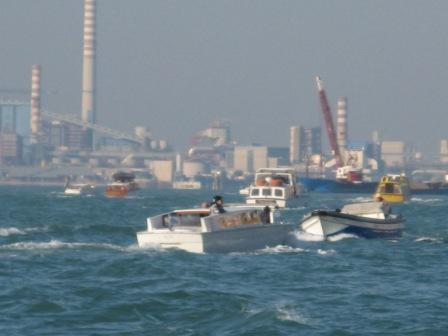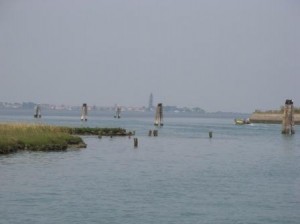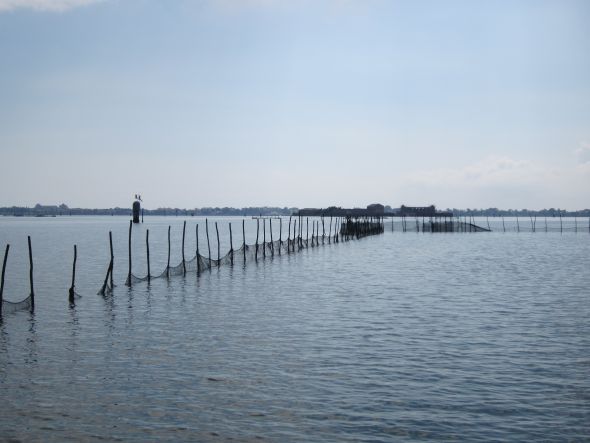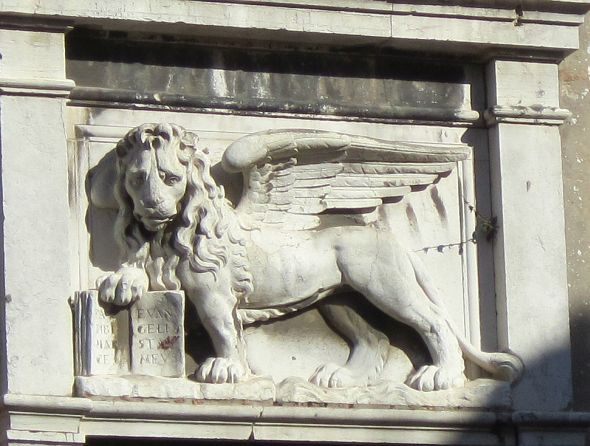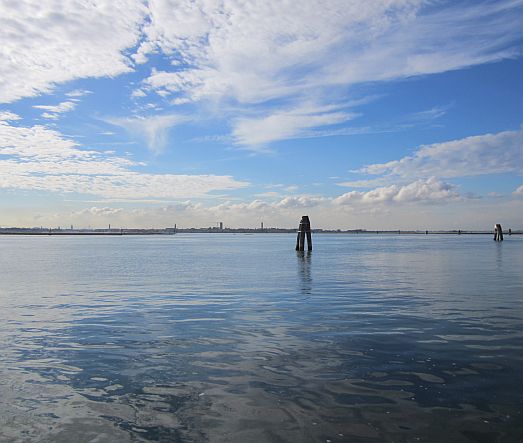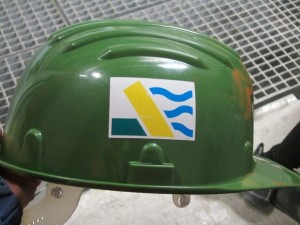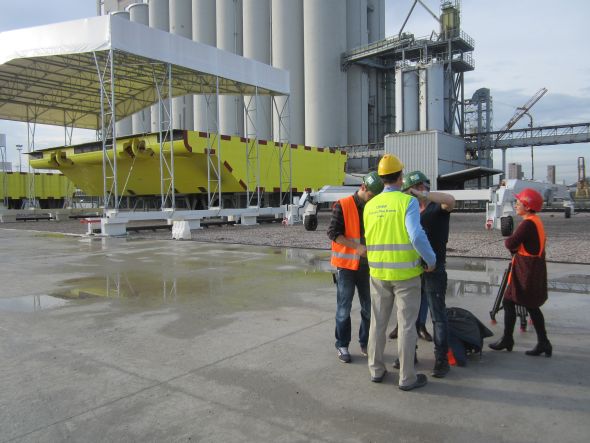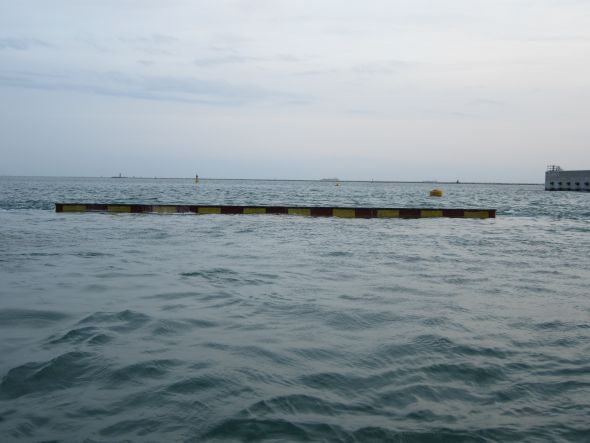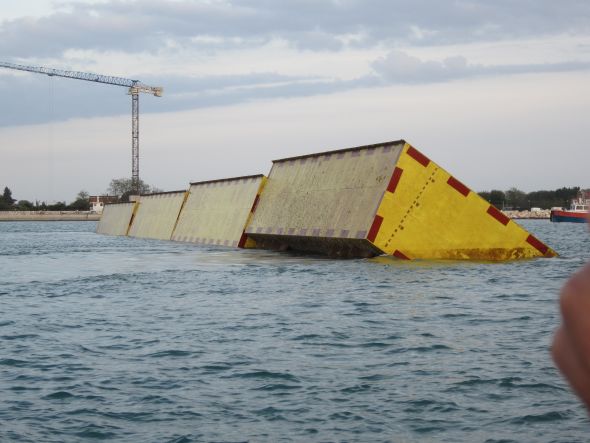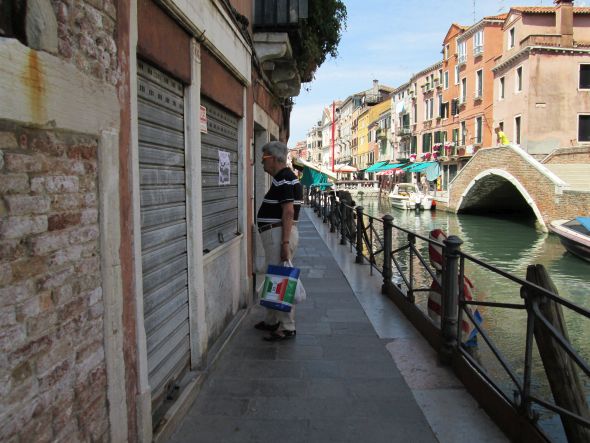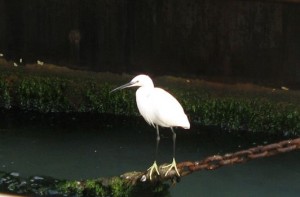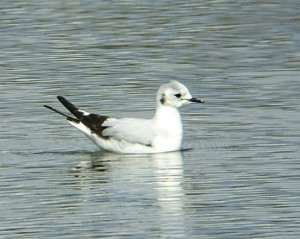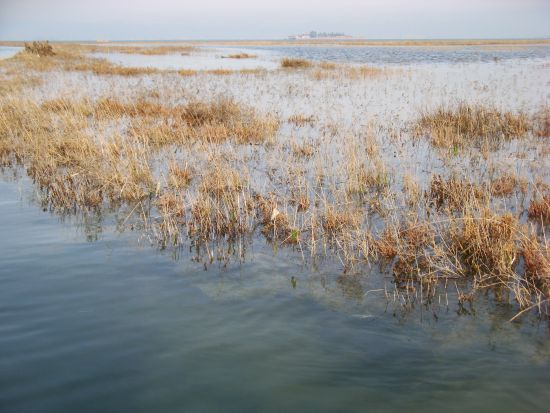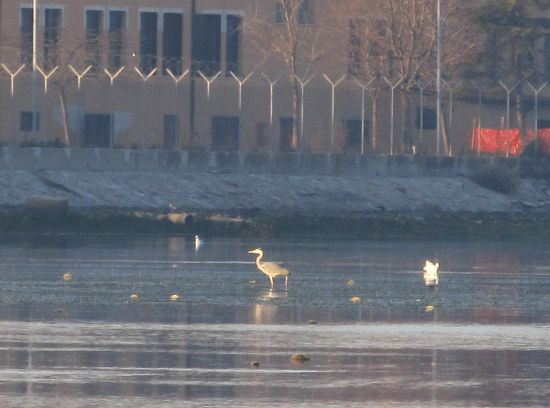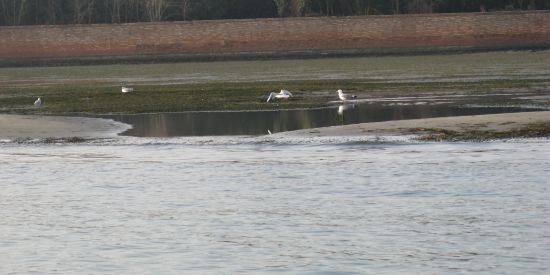A few times each year, the subject of motondoso leaps into the headlines. I wrote about some of this phenomenon a good while ago. While I wait for more pressing news to emerge, I will add this post to the general fund of knowledge. Don’t be looking for a happy ending.
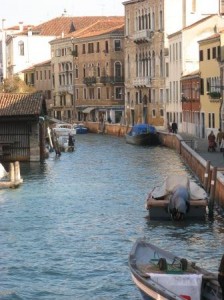
- Studies by the Venice Project Center have shown several facts in crisp detail.
- The height of the waves increases exponentially as speed increases. A small barge traveling at 5 km/h would produce a wake about 2 cm high. The same boat going at 10 km/h produces a wake of nearly 15 cm. (Multiply the speed by 2, multiply the wake by 7.)
- Virtually all boats exceed the speed limit. The average speed on all boats in all canals was 12 km/h, which is more than 7 km/h over the maximum speed limit.
- Therefore, reducing the speed of the boats would drastically decrease the size of their wakes.
The area available for waves to dissipate. This is a crucial factor because all these hydrodynamic formulas wouldn’t have to matter except for those pesky canals, whose walls trap the waves.
The waves travel till they hit a wall, then bounce back, then hit the other wall, and this continues till they wear themselves out and disappear. Depending on how much traffic passes in the canal in question, they might disappear sometime around midnight. Typically, enough boats a day (and it doesn’t have to be thousands) pass through so many canals making so many waves that they don’t have time to dissipate, so they just keep going, banging back and forth into each other and into each side of the canal, each time giving just another little hammer-blow to whatever building they reach. That probably didn’t need to be explained. The depth of the water also influences the waves in certain ways, but of course the depth varies according to the tide, so let’s move on.
Who suffers?
Building foundations. This is obvious. Some Venetians have told me that they believe nothing will be done to resolve this situation till an entire building collapses. Stay tuned.
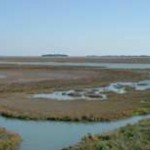
- The lagoon, more specifically the barene and everything that depends on them. I will say more on this on my page about the lagoon, but briefly, the barene (bah-RAY-neh) are the marshy, squidgy islets strewn about the lagoon.
They form 20 percent of the lagoon area, and their benefit is to the entire lagoon ecosystem: microorganisms, plants, animals, birds, fish. For millennia they also slowed down the speed and force of the tide, but as the waves continue to obliterate them (50 percent of the barene have been lopped away by waves in 60 years), their benefits are denied to everyone. So it’s not only the foundations of buildings which are under attack, so are the foundations of the lagoon.
People. Waves are a hazard to ordinary people in several ways. The most obvious is the risk of capsizing. Even on land, you can’t be sure you’re safe. The insidious subterranean erosion caused by the waves continually sucking soil out from under pavements means that sometimes a person suddenly falls into a hole. It happened to a woman walking along near the Giardini one day — she put her foot on a stone, it collapsed, she fell into a hole higher than she was. Nobody in the neighborhood was surprised; they’d been sending complaints to the city to no avail. Then there was the child playing on a stretch of greensward at Sacca Fisola facing the Giudecca Canal who suddenly fell into an unsuspected weak spot in the ground. If a man with quick reflexes hadn’t grabbed him, the child would have long since gone out to sea.
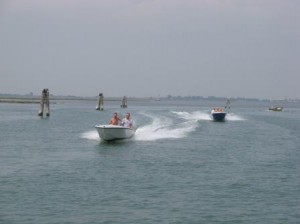
The Venetians have a saying: “Water has no bones.” This means that water can go anywhere it wants to. They should know — Venice has a long history of brilliant hydraulic engineering, up to and including cutting the river Po to re-route it southward, thus preventing the eventual silting-up of the lagoon. If they hadn’t done this in 1604, Venice would have long since been surrounded by cornfields. Or more probably by the world’s biggest parking lot. This knowledge and sense of self-preservation now exists only in a vastly sub-divided and disconnected form which only serves one tiny, specific purpose, usually unrelated to any larger context.
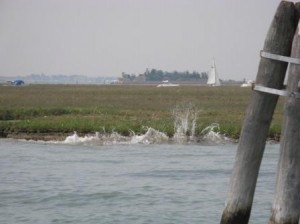
Who’s responsible?
Division of jurisdiction. The term “battle against motondoso” is now a cliche. But exactly who is conducting this battle? By now there is “an exuberance,” as the Italians might put it, of agencies and organizations involved in some way in managing the lagoon. The Magistrato alle Acque was established in 1501 to resolve administrative conflicts and simplify redundancies. Now it’s just one more in the herd. The lagoon is divided into areas overseen by agencies representing a large array of sometimes incompatible interests, charged with enforcing laws which sometimes contradict each other. The waters lapping at Venice’s feet are subdivided according to their primary use: shipping channels, small internal canals, approaches, which are variously overseen by the Capitaneria di Porto, the Magistrato alle Acque, the city of Venice and/or the province of Venice. Parts of the lagoon have been designated as Special Protection Areas (SPA) under the European Habitats Directive, but they exclude the central part of the lagoon, the major shipping lanes, and the shoreline Industrial Area — just the places where motondoso is most likely to be found.

Everybody with a boat. Over time, the voices blaming everyone else blend like an entire city singing “Three Blind Mice.” (I would say “Row, row, row your boat,” but that would be silly.) The vaporetto drivers say it’s the barges. The barge drivers say it’s the taxis. The taxi drivers say it’s the private boats. The private boats say it’s everybody but them. And so it goes. I’m not sure what the legal value is of a defense strategy formed around “I did it, but he did it worse.” But whoever is in a motorboat for work reasons considers himself to have a free pass. And whoever is in a motorboat for fun automatically counts himself out because he’s not there every day, so how could he count as a culprit?
Studies by the Venice Project Center have revealed that the highest wakes are produced by the small barges (“topo-motore“). Next were the taxis. Vaporettos produced the least, but that doesn’t let them off the hook entirely, for two reasons. One, “least” doesn’t mean they produce no wake, so I don’t regard “least” as any kind of gold star. Second, instead of bigger waves they produce something which none of the other motorboats do, which is a powerful whirlpool.

Every time a vaporetto ties up to the dock to let passengers on and off, the motor stays in full-steam-ahead mode. The reason given is that it makes the boat more secure for the passengers in transit. I won’t contest that here, but will say that the vortex creates a kind of suction effect (think of rinsing out your mouth) which is also damaging to the nearby foundations.
What to do? Stricter enforcement of speed limits. It’s the most obvious solution, even to Venetians. Generally speaking, the limit in the small inner canals is 5 km/h, in the Grand Canal and some larger canals it’s 7 km/h, and in some others (such as the Canale di Tessera leading to the airport) it’s 11 km/h. But, as noted earlier, these are just numbers on a page. Many and varied have been the proposals, most of which have some merit but which frequently suffer from the fatal flaw of being unenforceable. Shortage of personnel, inter-bureau jealousies, and lack of consistency and simple lack of will on the part of everyone has shown this solution to be impossible. I don’t mean literally impossible, I just mean impossible here. Require hulls and horsepower to be changed to the minimum-wave-producing conformation. Nobody wants to pay to get a new boat with a less wave-inducing hull, though it occurs to me that now would be a brilliant moment to launch a “Cash for Clunkers” program for commercial boats. If cost is the only thing holding people back (it isn’t) this would be an intelligent place to start. If it’s not cost, what is it? Civic pride isn’t even mentioned as an incentive.
It’s Sloth. “We’ve always done it this way.” “It’s too much trouble.” “Why me?” How to overcome that? You can’t. It’s as difficult to convince workers-with-boats as it is poachers that they are gradually killing their source of livelihood. You can only create a new situation and then enforce it till it becomes habit. I have several solutions in mind, each of which would have an appreciable, even dramatic, effect on motondoso. The costs involved are all to be considered as investments in the future not only of the person using the boat, but of the city itself.
-
- Redesign the vaporettos. Actually, this was on the way to being done, then the project slowly sank from sight and history into the swamp that is the political biosphere here. You should have a look at the Mangia Onda (wave-eater) hull design, and the prototype airport launch. The prototype had the advantage of being paid for by its inventor, which got it very far down the road. That was in 2001. The documents must be in a drawer somewhere. Or as one site sums up: “Don’t even ask what happened.”
- While that is going on, reconfigure the timetables to impose slower — much, much slower — speed limits on everybody. I don’t know why this seems to be such a difficult idea; evidently the mania for speed has blinded everyone to the fact that these changes would only involve five or fifteen — let’s say twenty, hey — minutes more for each run. Passengers, be they residents or tourists, can’t plan for an extra twenty minutes in transit? Why? They do it on an unplanned basis on the mainland all the time — all it takes is an accident somewhere and traffic backs up forever. Why do water-buses have to go faster? To carry more people?
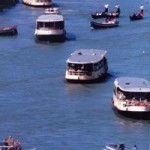
- There are already so many vaporettos in operation that, especially in the Grand Canal, they have to just float there in neutral, waiting their turn to tie up at the dock while the previous boat finishes and casts off. If we were to see buses on the mainland pulling over to wait until their stop became available on a regular basis, we’d think it was kind of nutty. Same for boats. It’s a sign of unintelligent management.
- Install permanent cofferdams to protect anything a wave can reach. This would be most of the city and its canals. Not pretty, perhaps, for tourists who like to think the city is still living in the 15th century, but then again, the same tourists use vaporettos, taxis, launches, and other motorized boats and don’t seem to find it aesthetically jarring. This approach has always been used in the short-term to make it possible to repair ravaged structures; 50 years ago, squads of men beat a row of tightly connected wooden pilings into the sediment, and blocked it with dense lagoon mud to keep out the canal’s water. Today, there are always places in the city where you can see iron cofferdams serving the same purpose. I’d say if you’ve got them, just leave them there. And add them to the rest of the city’s edges.
- Change human nature. (I’ll get right on that.) Or how about changing the political landscape? Not much easier. But the city government has a view of its purpose in life whose range is far, far too short. Grandiose goals, certainly, but they’re sliced and diced, doled out here and there, or left to rot. The political philosophy here appears to qualify as what Herbert Marcuse called “repressive tolerance.” A good example is when your father says, “Yes, you can have it, but not today.” You don’t say no, but it never happens anyway. The city government has become expert at this maneuver.
If I were in charge, I would add the following to all of the above:
- Require completely new hull forms for each category of boat (for instance, returning the taxi to its primordial motorized shape, with the motor in the center of the boat rather than the stern, which creates much more wake).
- Most, if not all, of these hulls would be of the “wave-eating” form, a heretofore experimental design invented in 1998 by Americans Bill Burns and Charles Robinson . Its few demonstration runs have shown it to be effective but nobody has studied the effect of large numbers of them. Still, it’s a dramatic start. There is a saga behind all this, too, because in 2001 the company announced that one of these boats would be in service by the end of that year. As another web-site devoted to this project put it, “As for what happened, don’t even ask.”
I would also stipulate a limit on the horsepower of each category, including pleasure boats. Since people can’t retain the concept of slowing down on their own, I suggest requiring their equipment do it for them. As for those who might protest, I would have a one-size-fits-all response: Do it or seek employment elsewhere. The world must be full of people who would be happy to work for even one quarter of what your average taxi driver (I refer to the legal ones, not the fleet of illegal ones) makes in a year. Or even what they make in a month. If this notion for some reason is deemed unfeasible (I can’t see why), I would suggest immediately hiring a large quantity of extra police solely to enforce speed limits, imposing fines so steep that a quick calculation on the back of an envelope would show that it made more sense to buy a new, non-wave-making boat right now than pay two fines. The vital element here is that a person has to be at least 99 percent convinced that he will be caught and fined, a certainty which can’t exist today when the forces of public order have been reduced to skeleton crews who mainly race around solving emergencies.
The councilor for Tourism and Decorum, Augusto Salvadori, made a proposal some while back (I think he even may have made it twice): Engage squads of volunteers from the ranks of the rowing clubs, whose job would be to row around and blow whistles at whatever transgressors they encounter. This might possibly work (I’m being generous here) if there were enough people, if there were immediate and drastic follow-up, and if the transgressors weren’t inclined to run you over. My sense is that none of these conditions apply. Well, there’s prayer. They’ve tried that too. A few years ago there was a big initiative to amass members of all of the rowing clubs at the church of the Madonna della Salute (Our Lady of Health) on November 21, her feast-day. Considering that she saved Venice in 1630 from the catastrophic plague which was destroying the city, there was some poetic power in the notion of everyone going to her church and offering a candle in supplication for salvation from this latest plague. Grand symbolic gestures are so much fun; they make everybody feel so good. Reminds you of why Italian opera is so impressive. Then it’s over, and everybody goes home. And tomorrow begins just like it did yesterday, and nothing has changed.
